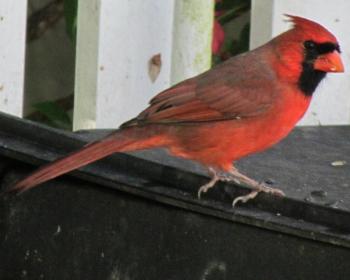Red birds on white
There’s no doubt that one of the favorite birds of many Mainers is the Northern cardinal. One view of a brilliant red male against white snow and you can see why.
Many people might be surprised to know that there were fewer than about 10 known records of Northern cardinals in Maine prior to 1949. Some of the earliest records were thought to refer to escaped cage birds. Audubon Christmas Bird Counts in Maine did not start registering the species until 1969, when two locations reported a total of four birds.
Last year nearly 1,400 were tallied from 30 Christmas Bird Count locations! Even as late as the early 1980s, Northern cardinals were restricted as breeding birds to the southern Maine coast and scattered locations in the lower Kennebec River drainage, and numbers were not high anywhere.
Today they occur commonly north through Bangor, and in small numbers in most settled parts of Washington County and Aroostook County. The expanding northern range edge for Northern cardinals is now in the Canadian Maritimes, where 30 years ago it was here in Maine.
Even when you can’t see a male cardinal, the male’s exuberant song is hard to miss. Many a light sleeper has been awakened at dawn by a male cardinal’s loud whistled “too-weet, too-weet, too-weet, cheer, cheer, cheer” from the top of a tree near the bedroom window.
Like other species, he sings to establish and hold a territory from which he tries to exclude other male cardinals and to attract or retain a female. Here in Maine the song may start to be heard regularly in March, but typically reaches a peak in April and May where, in some neighborhoods, with a careful listen you may identify three or four males all battling it out over the airspace.
Listen particularly closely and you may notice them matching the different song variants from the closest neighbor. This is apparently their own way of letting neighboring rivals know that they are aware of them; it’s also a way to show that they are accomplished and experienced songsters that should be taken seriously by both competitors and potential mates.
In May and June, the female Northern cardinal will build an open cup nest in thick shrubs where she will lay her 2-5 eggs. Later in the summer it’s not uncommon to see a pair of male and female birds feeding the loudly begging and chipping young in tangles of bushes as they move quickly toward independence. The strong territoriality of male cardinals seems to break down in winter, as it is not uncommon in some areas to see multiple pairs at the same backyard feeding station.
The prevalence of winter bird feeding stations and the increase in suburban habitats are both factors that have been implicated in the northward spread of the Northern cardinal. But although they may have played a role, this northward range expansion is only one of many shown by birds and other animals and plants over the last century that is a general biological response to climate change.































.png)

.png)
